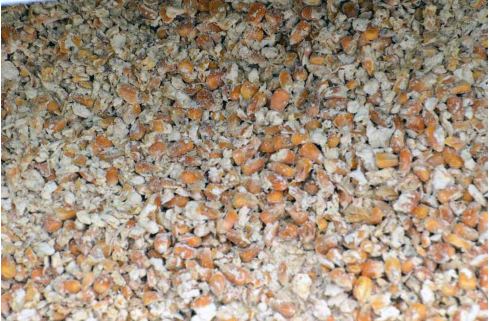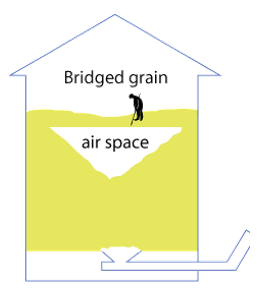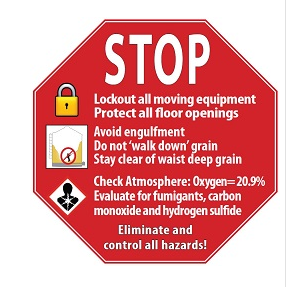by
[user not found]
| Aug 11, 2014
Here are 7 tips for helping to promote and enforce a safer workplace in the feed, grain and agriculture industry.
An Unlikely Appearance on the 'Most Dangerous Workplaces' List
In a 2012 article, Yahoo listed the Most Dangerous Workplaces and Industries in the US. The list was based on an analysis to determine which industries had the most "fatal occupational injuries" in the United States. Not surprisingly, Fishing, Mining, Roofing, and Law Enforcement were on the list. The one that struck us was the inclusion of Farming and Agriculture.
Farming brings to mindo images of the American family and the heartland of the United States. We envision "amber waves of grain" and Chevy Trucks, of people rolling up their sleeves and working an honest day's work for an honest day's pay.
The reality however isn't always so rosy. Farming involves using heavy machinery, transporting and storing massive amounts of corn, grain, feed, etc., working in and around silos, elevators, railcars, livestock and other hazards.
One of the leading causes of death particularly in feed and grain is death by suffocation. According to OSHA:
"Suffocation is a leading cause of death in grain storage bins. In 2010, 51 workers were engulfed by grain stored in bins, and 26 died-the highest number on record, according to a report issued by Purdue University (PDF). Suffocation can occur when a worker becomes buried (engulfed) by grain as they walk on moving grain or attempt to clear grain built up on the inside of a bin. Moving grain acts like "quicksand" and can bury a worker in seconds. "Bridged" grain and vertical piles of stored grain can also collapse unexpectedly if a worker stands on or near it. The behavior and weight of the grain make it extremely difficult for a worker to get out of it without assistance.
Grain bin safety is the subject of extensive measures and safety bulletins from a number of industry leaders, influencers, and outside groups including NationWide Insurance. Industry publications including Corn and Soybean Digest published 7 Tips for Grain Bin Safety and The National Grain and Feed Association even hold their own conferences focused entirely on safety in grain manufacturing and how to combat preventable, accidental deaths. Even entire websites including SafeGrain.com exist for the sole purpose of promoting awareness for this problem. More resources and organizations are listed below.
Here's a curated list on Grain Bin Safety: 7 Tips for a Safer Workplace
Grain Bin Safety: 7 Tips for a Safer Workplace
1. Manage grain to prevent spoilage
 Preventing conditions that would result in engulfment and suffocation is not difficult. In fact, many of prevention strategies are rooted in common sense and clear procedures.
Preventing conditions that would result in engulfment and suffocation is not difficult. In fact, many of prevention strategies are rooted in common sense and clear procedures.
Key reasons why workers enter grain bins include cleaning out a grain bin, or addressing an issue with the grain itself. Issues include spoiled grain (above) or clogged grain. Spoiled grain can take on many different forms. The grain can form solid masses or crusts on top of or around the interior walls of the bin. Fixing these types of problems usually requires unloading the bin.
Entering a grain bin is a dangerous condition!
In the case of spoiled grain, grain can crust over and solidify forming vertical walls of grain (below) that are extremely fragile. Once the mass is disrupted, the grain can collapse on workers, engulfing them. Additionally, spoiled grain can plug augers and conveyors leading in and out of the bin. Assessing this kind of issue is just as important as dealing with spoiled grain and risks are no fewer.
To reduce the likelihood of grain molding, spoiling and clogging up grain bin hardware:
- Make a point to check, maintain and clean up aeration equipment and generally keep it in optimal working order.
- Check the roof of the bin for leaks. Water plus a cool, damp environment is asking for mold generation.
- Be sure to keep grain at the correct moisture content and temperature.
- Aerate to cool grain quickly at the time of storage, remove the core of fines that is most prone to spoilage, and monitor for pests, off-odors, hot spots, and moisture content to help prevent spoilage.
2. Always have an outside observer with a quick method to contact emergency responders if necessary.
A better solution is to work from outside the bin whenever possible. If there is a problem with the bin or grain with clumps or crusting over, use a pole or another device to poke and fix the problem rather than climb inside of the bin.
The best solution is to prevent the conditions that would require someone to enter the bin or silo. VIBCO produces a number of products including the Air Cannon, large electric vibrator and a high frequency electric vibrator that solve most bin clog issues.
3. Ensure that there’s adequate lighting inside of the area you're working in and have a written plan for training and rescue
Lighting is key when working inside of this kind of environment. As small slips can quickly turn into a life or death situation, it's smart to make sure that the area you're working in is well lit and any areas where there is a chance to misstep or be caught off guard are in plain, unobstructed sight.
 While suffocation by being overtaken by moving grain is certainly the way that makes the news the most often, there are in fact two other ways where workers can get trapped in a grain bin.
While suffocation by being overtaken by moving grain is certainly the way that makes the news the most often, there are in fact two other ways where workers can get trapped in a grain bin.
The second way is the collapse of bridged grain. Bridged grain is when a layer of grain forms over a pocket of air. When enough weight is applied to the bridge, it will collapse and the worker will immediately be engulfed in grain.
The third way is by a collapse of a vertical wall of grain. When workers are cleaning out a bin, a vertical wall is likely to emerge.
In all of these instances, the risk is that a large volume of grain will move suddenly. The best offense is a good defense. Make sure that your facility has a training guide and routinely reviews proper procedures and protocols for working around grain.
http://farmsafety.mo.gov/grain-bin-safety/
5. Never enter a grain bin alone – always have an outside observer who can see you and hear you clearly
Remember the buddy system that was used so much during elementary school field trips? Well, the same principle applies here as an adult working in agriculture. When working in a hazardous environment, working alone can easily be the biggest danger of all and certainly the most preventable.
6. Label and lock your grain bins
 There is always the risk of someone wandering into your grain bin who is unaware of the hazardous conditions. Therefore, it's critical for the safety of others - friends, loved ones, other farmers, business people, etc. to know that grain bins are dangerous environments.
There is always the risk of someone wandering into your grain bin who is unaware of the hazardous conditions. Therefore, it's critical for the safety of others - friends, loved ones, other farmers, business people, etc. to know that grain bins are dangerous environments.
Take steps to create a very eye grabbing, visual sign that explicitly states the hazards of the grain bin.
Moreover, when the grain bin is not being used, lock access to the space up as to prevent unauthorized persons, bystanders and children from entering.
7. Evaluate the atmosphere of the bin regularly and before entry
Grain bins can accumulate toxic gases if not checked and aerated regularly.
Use a gas meter or another properly calibrated and approved air quality indication tool specifically for the purpose of measuring the oxygen to other gas ratio in a given area. Carbon monoxide, carbon dioxide and fumigants are some of the most common silent killers quietly accumulating in grain bins.
Above all else, trust your nose and your gut judgment when assessing the air and oxygen quality in a grain bin. If the bin smells moldy or not 'fresh', assume that the bin needs to be aerated. Moreover, if the smell of mold is present, this is also a good indicator that there are likely to be grain verticals accumulating along the walls waiting to fall over and trap a worker.
Here's a handy chart courtesy of the Great Plains Center for Agricultural Health to refer to when checking air quality:
| | Do not enter if: |
| Oxygen level | < 19.5% or > 23.5% |
| Carbon monoxide | > 25 ppm |
| Toxic gases: Hydrogen sulfide Phosphine | > 10 ppm > 0.3 ppm |
| Odors | spoiled grain, chemicals, or smoldering, burning odors are detected |
| Dust | Vision is obscured to < 5 feet |
Additional Power Players in Grain Safety
You can never be too safe.
Here are some additional resources and organizations that are making safety in the agricultural workplace their top priority. Each of these organizations also provides some helpful downloads, links and PDFs to walk away with:
1. Occupational Safety & Health Administration
2. Feed and Grain Associates of Illinois
3. University of Illinois Agriculture Safety nad Health
4. AgChat Foundation
5. Farm Safety for Kids
6. 15 Safety Tips from Ag Chat